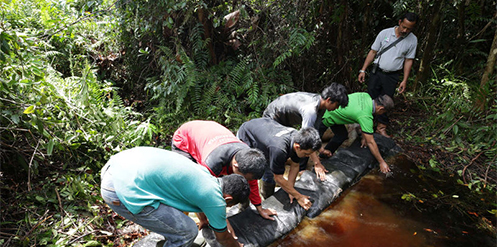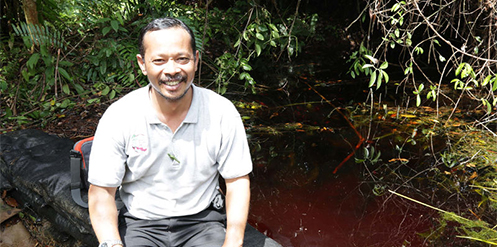January 17, 2018
Even for our experienced rangers, it can be difficult to navigate the forest of restoration and conservation area RER. There are no paths or roads, vegetation is thick and the waterlogged soil can be treacherous.
So imagine making that same journey while carrying a 30kg sandbag on your back.
That’s the challenge faced every day by our canal blocking team, who must sometimes carry the heavy bags for miles in order to build the dams that are a vital part of their work.
Before RER was established, parts of the Kampar Peninsula were used by illegal loggers who would dig canals to make it easier to remove the trees. When they had finished they would abandon the canals, which over time lower the water table and dry out the peat soil. The dry soil releases carbon into the atmosphere as the organic matter it contains decomposes, and makes the area more susceptible to fire.

Closing off these canals is a vital part of RER’s restoration efforts, explains Ronyi Las Silaen, Head of Forest Protection. “Blocking the canals is one of the keys to restoring and managing peat moisture level, and it will also become a source of water for wildlife in the forest.”
Sand and stones are brought to a central location by truck and the sandbags are filled by hand, with each person able to make around 30 bags per day. From there though the roads end, and the most difficult part of the journey must be completed on foot.
“We have to carry them on our backs for miles to block the canals, because the canals are too deep within the forest and it is impossible for us to reach them with a truck,” Ronyi says.
Besides having to shoulder 30kg loads each, the team also finds it difficult to navigate to their destination, as most areas within the forest are wetlands. For particularly remote areas the journey can take more than a day, meaning the team must spend the night in the jungle. “Some dams take weeks to build – it depends on how big the canals are and how deep into the forest we need to go.
“Sometimes we need help from the rangers who know the forest better,” Ronyi says.

In building a dam, open canals must first be identified and undergo detailed topographic leveling surveys so that the length and gradient of each canal can be determined.
Based on this survey, water managers can then identify the exact location to build dams, as well as the number of dams needed in order to raise water levels.
However, the team also needs to wait for the best weather to block the canals as some areas will be flooded if it rains.
“It is hard if we do it if the area is flooded but we also don’t want to wait until it is drained,” Ronyi says.
A series of 50cm steps, similar to terraces, are constructed to slowly raise the water table, soaking the peat and restoring it to its natural condition.
“To block a small canal, we need at least 50 sandbags and this material can last for 10 years,” says Ronyi.
So far, Ronyi and his team have managed to build 23 dams to block off eight canals measuring more than 27km in length. But that is not the end of the process. The team also revisits the area to monitor the subsequent impact on the forest, as well as to monitor the health of the dam itself.
“Especially when it rains heavily, we need to make sure the sandbags are still there,” Ronyi says.